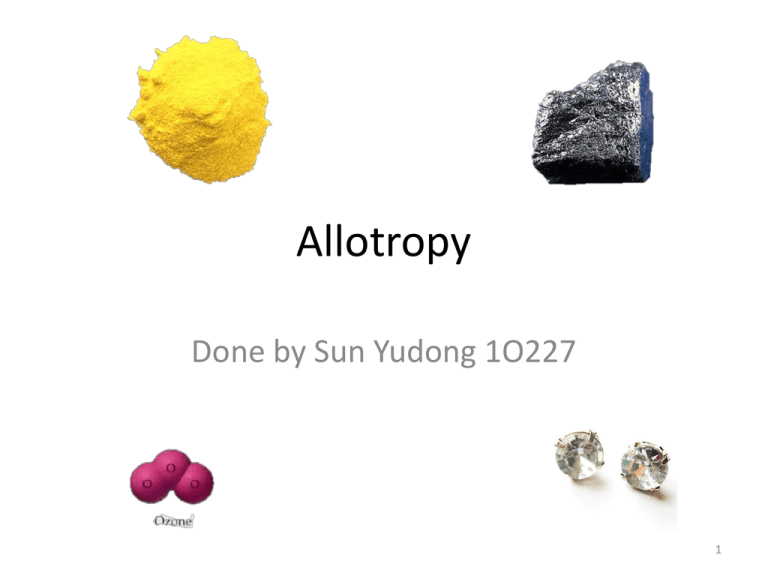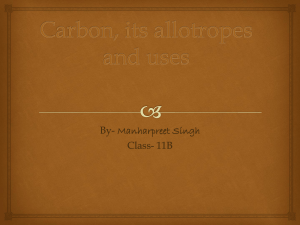Allotropes - WordPress.com
advertisement

Allotropy Done by Sun Yudong 1O227 1 What is allotropy? of an element existing in two or more physical forms • the property of some chemical elements to exist in two or more different forms – known as allotropes of these elements • different structural modifications of an element 2 What about allotropes? • a structurally different • forms of the same element which exhibit different physical properties. – different physical properties displayed by allotropes of an element • atoms are arranged into molecules or crystals in different ways. • Some allotropes of an element may be more chemically stable than others. 3 • Elements such as 4 • Allotropy refers – i.e. different solid, liquid or gas forms • The changes of state between solid, liquid and gas in themselves are not considered allotropy. • e.g. → 5 Common Allotropes – 4 common – atoms bonded together in a tetrahedral lattice arrangement – atoms bonded together in sheets of a hexagonal lattice • – single sheets of graphite – atoms are bonded together in spherical, tubular, or ellipsoidal formations 6 Allotropes • For some elements, allotropes have different molecular formulae which can persist in different phases – E.g.. 2 allotropes of • Oxygen Gas(dioxygen)(O2 ) • Ozone (O3) can both exist in the solid, liquid and gaseous states. 7 Allotropes • Conversely, some elements do not maintain distinct allotropes in different phases – E.g. • has numerous solid allotropes – all revert to the same P4 form when melted to the liquid state. Pure phosphorus exists in several forms called allotropes. This photo shows waxy white phosphorus (yellow cut), red phosphorus, violet phosphorus and black phosphorus. The allotropes of phosphorus have markedly different properties from each other. 8 List of Elements with Allotropes (Some Non-metals and metalloids) 9 Some Elements with Allotropes (Metals(at ambient pressure)) 10 Some Elements with Allotropes (Metals(Considering only the technologically-relevant metals)) at 882°C at 912°C and 1394°C at 422°C at 863°C at 13°C at 668˚C and 776˚C 11 6th element of the periodic table ALLOTROPES OF 12 • Allotropes • Graphene or buckytube (h) • Buckminsterfullerene or buckyball – Carbon nanotubes » Carbon nanobuds – – – – Glassy carbon Atomic and diatomic carbon Carbon nanofoam Linear acetylenic carbon (LAC) • A one-dimensional carbon polymer with the structure (C:::C)n- 13 Diamond • an extremely hard, transparent crystal, with the carbon atoms arranged in a tetrahedral lattice. • A poor electrical conductor. • An excellent thermal conductor. • one of the best known allotropes of • hardness and high dispersion of light – make it useful for both industrial applications and jewellery • Diamond is less stable than graphite – but the conversion rate from diamond to graphite is negligible at ambient conditions. 14 Diamond • Diamond has remarkable optical characteristics. • Due to its extremely rigid lattice, it can be contaminated by very few types of impurities, such as and . WellPromo.com 15 Diamond • Small amounts of defects or impurities (about one per million of lattice atoms) colour diamond – – – – – – – – blue ( ) yellow ( ) brown (lattice defects) green (radiation exposure) Purple Pink Orange Red. • Diamond also has relatively high optical dispersion (ability to disperse light of different colours), which results in its characteristic luster. 16 Diamonds • Most natural diamonds are formed at highpressure high-temperature conditions existing at depths of 140 to 190 kilometres in the Earth mantle. • Carbon-containing minerals provide the carbon source • the growth occurs over periods from 1 billion to 3.3 billion years – (25% to 75% of the age of the Earth) 17 Diamonds • Answer? – Diamonds are brought close to the Earth surface through deep volcanic eruptions by a magma, which cools into igneous rocks known as kimberlites and lamproites. 18 Diamonds • Then where do they get so many diamonds? – Synthetic • Diamonds can also be produced synthetically in a highpressure high-temperature process which approximately simulates the conditions in the Earth mantle. • Chemical Vapour Deposition (CVD). – Several non-diamond materials, which include cubic zirconia and and are often called , 19 A rough natural Diamond 20 Diamonds • Special gemmological techniques have been developed to distinguish natural and synthetic diamonds and diamond simulants. 21 Diamond • The most popular gemstone. Why? – Excellent optical – Excellent mechanical properties – efficient marketing 22 Graphite • a soft, black, flaky solid, a moderate electrical conductor. • The C atoms are bonded in flat hexagonal lattices (graphene), which are then layered in sheets. 23 Graphite • Naturally found in Sri Lanka, Canada and the United States. • Named by Abraham Gottlob Werner in 1789 from the Ancient Greek γράφω (graphō), “to draw/write” • Named for its use in pencils, where it is commonly called lead 24 Graphite • Made of layers of carbon atoms – These layers can slide over each other very easily. • meaning that it is very soft • Unlike diamond, graphite is an electrical conductor, a semimetal. • Due to the delocalized electrons between the layers, it can conduct electricity very well. • Graphite is the most stable form of carbon under standard conditions. – Thus, used in thermochemistry as the standard state for defining the heat of formation of carbon compounds. 25 Graphite • Graphite can be formed from coal put under high heat and pressure. • Graphite can also be turned into diamond with enough heat and pressure. – This is one way how synthetic diamonds are made. 26 Graphite • Some uses – It can be used as a lubricant to make mechanical devices run smoother. – The most common use of graphite is the "lead" in a pencil, which also has clay. 27 Graphene • an allotrope of carbon • structure is one-atom-thick planar sheets of sp2-bonded carbon atoms that are densely packed in a honeycomb crystal lattice Graphene is an atomic-scale honeycomb lattice made of carbon atoms. 28 Graphene • A single layer of graphite is called graphene and has extraordinary electrical, thermal, and physical properties. • It can be produced by epitaxy on an insulating or conducting substrate or by mechanical exfoliation (repeated peeling) from graphite. • Its applications may include replacing silicon in high-performance electronic devices. 29 Graphene • Graphene is most easily visualized as an atomicscale chicken wire made of carbon atoms and their bonds. • The crystalline or "flake" form of graphite consists of many graphene sheets stacked together. • The carbon-carbon bond length in graphene is about 0.142 nanometers. • Graphene sheets stack to form graphite with an interplanar spacing of 0.335 nm – which means that a stack of three million sheets would be only one millimeter thick. 30 Graphene • Graphene is the basic structural element of some carbon allotropes including – Graphite – Charcoal – Carbon nanotubes – Fullerenes Graphene Paper 31 Lonsdaleite • named in honour of Kathleen Lonsdale • an allotrope of carbon with a hexagonal lattice • also called hexagonal diamond – in reference to the crystal structure Crystal structure of Lonsdaleite 32 Lonsdaleite • In nature, it forms when meteorites containing graphite strike the Earth. – The great heat and stress of the impact transforms the graphite into diamond, but retains graphite's hexagonal crystal lattice. • first identified in 1967 from the Canyon Diablo meteorite, where it occurs as microscopic crystals associated with diamond 33 Amorphous carbon • Amorphous carbon is the name used for carbon that does not have any crystalline structure. • As with all glassy materials, some short-range order can be observed, but there is no long-range pattern of atomic positions. • While entirely amorphous carbon can be produced, most amorphous carbon actually contains microscopic crystals of graphite-like, or even diamond-like carbon. 34 Amorphous carbon • Coal and soot or carbon black are informally called amorphous carbon. – However, they are products of pyrolysis (the process of decomposing a substance by the action of heat), which does not produce true amorphous carbon under normal conditions. – The coal industry divides coal up into various grades depending on the amount of carbon present in the sample compared to the amount of impurities. – The highest grade, anthracite, is about 90% carbon and 10% other elements. – Bituminous coal is about 75-90% carbon, and lignite is the name for coal that is around 55% carbon. 35 Buckminsterfullerenes • C60 • The buckminsterfullerenes (or usually just fullerenes or buckyballs for short) were discovered in 1985 by a team of scientists from Rice University and the University of Sussex – three of whom were awarded the 1996 Nobel Prize in Chemistry. • They are named for the resemblance of their alliotropic structure to the geodesic structures devised by the scientist and architect Richard Buckminster "Bucky" Fuller. • Fullerenes are molecules of varying sizes composed entirely of carbon, which take the form of a hollow sphere, ellipsoid, or tube. 36 Buckministerfullerenes • As of the early twenty-first century, the chemical and physical properties of fullerenes are still under heavy study, in both pure and applied research labs. • In April 2003, fullerenes were under study for potential medicinal use — binding specific antibiotics to the structure to target resistant bacteria and even target certain cancer cells such as melanoma. 37 Carbon nanotubes • Carbon nanotubes, also called buckytubes, are cylindrical carbon molecules with novel properties that make them potentially useful in a wide variety of applications – e.g., nano-electronics, optics, materials applications, etc. • They exhibit extraordinary strength, unique electrical properties, and are efficient conductors of heat. 38 Carbon nanobuds • Carbon nanobuds are a newly discovered allotrope of carbon in which fullerene like "buds" are covalently attached to the outer sidewalls of the carbon nanotubes. • This hybrid material has useful properties of both fullerenes and carbon nanotubes. • In particular, they have been found to be exceptionally good field emitters. Computer models of several stable nanobud structures 39 Glassy carbon • or vitreous carbon • is a class of non-graphitizing carbon widely used as – An electrode material in electrochemistry – For high temperature crucibles – As a component of some prosthetic devices. • can be fabricated as different shapes, sizes and sections, is a non-graphitizing carbon – which combines glassy and ceramic properties with those of graphite. 40 Glassy Carbon • It was first produced by Bernard Redfern in the mid 1950s at the laboratories of The Carborundum Company, Manchester, UK. • He had set out to develop a polymer matrix to mirror a diamond structure and discovered a resole (phenolic) resin that would, with special preparation, set without a catalyst. • Using this resin the first glassy carbon was produced. A small rod of glassy carbon. 41 Atomic and diatomic carbon • Under certain conditions, carbon can be found in its atomic form. • It is formed by passing large electric currents through carbon under very low pressures. • It is extremely unstable, but it is an intermittent product used in the creation of carbenes. • Diatomic carbon can also be found under certain conditions. • It is often detected via spectroscopy in extraterrestrial bodies, including comets and certain stars. 42 Atomic carbon Making atomic carbon :C: - The source of light is the electrical arcing between two carbon rods. Liquid nitrogen cools the reaction vessel. The black substance is soot. This photo was taken in the Laboratory of Professor Phil Shevlin at Auburn University. 43 Carbon nanofoam • Carbon nanofoam is the fifth known allotrope of carbon • discovered in 1997 by Andrei V. Rode and coworkers at the Australian National University in Canberra. 44 Carbon nanofoam • It consists of a low-density cluster-assembly of carbon atoms strung together in a loose threedimensional web. – Each cluster • is about 6 nm wide • consists of about 4000 carbon atoms linked in graphite-like sheets that are given negative curvature by the inclusion of heptagons among the regular hexagonal pattern. • This is the opposite of what happens in the case of buckminsterfullerenes, in which carbon sheets are given positive curvature by the inclusion of pentagons. 45 A video on YouTube on a discussion of carbon allotropes - including diamond, lonsdaleite, graphite, and the fullerenes. http://www.youtube.com/watch?v=vYkyUqUa 6vU 46 A video on a module on Allotropy http://www.youtube.com/watch?v=n22_6pCX 6e0 47 A Comic Strip on Allotropes 48 References • • • • • • • • • • • • • • • • http://www.increasemyvocabulary.com/definition/of/allotropy/ http://en.wikipedia.org/wiki/Allotropes_of_carbon http://en.wikipedia.org/wiki/Diamond http://en.wikipedia.org/wiki/Allotropes http://www.increasemyvocabulary.com/definition/of/allotrope/ http://www.ausetute.com.au/allotropy.html http://www.webelements.com/ http://simple.wikipedia.org/wiki/Allotropes http://simple.wikipedia.org/wiki/Graphite http://simple.wikipedia.org/wiki/Diamond http://en.wikipedia.org/wiki/Lonsdaleite http://en.wikipedia.org/wiki/Graphene http://en.wikipedia.org/wiki/Amorphous_carbon http://en.wikipedia.org/wiki/Buckminsterfullerene http://en.wikipedia.org/wiki/Glassy_carbon http://www.toondoo.com 49 50




